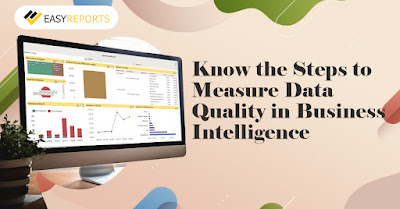Know the Steps to Measure Data Quality in Business Intelligence
Data is a quintessential part of Business Intelligence. You need to measure data quality and monitor the success of initiatives to improve data quality for a successful BI implementation.
The ability of a set of data to fulfill its intended function is referred to as data quality. You can use a variety of effective techniques to raise the quality of your data and incorporate data best practices throughout your organization.
Regardless of the strategy you choose to increase the effectiveness of your data, you must have a mechanism to evaluate the success of your work. If not, you'll be spending time and money on a data quality plan that might or might not be effective.
Accuracy
Accuracy
refers to events that happen in real-time, such as status changes or business
transactions. If source documentation is not available, then accuracy should be
assessed using independent confirmation approaches. It will show whether there
are any substantial inaccuracies in the data.
The
ratio of data to errors, which counts the number of known errors including
missing, incomplete, or redundant entries compared to the data set, is a common
metric to quantify accuracy. Naturally, this percentage should rise over time,
showing that the caliber of your data improves. There isn't a defined ratio of
data to mistakes because it depends so much on the size and type of the data
set, but obviously the higher the ratio, the better.
Consistency
According
to the definition of consistency, two data values taken from different data
sets should not conflict with one another. But correctness does not always
follow from consistency. A rule ensuring that the total number in each category
subset of data does not exceed the total count of data can ensure consistency
in the organization.
Completeness
Completeness
will show whether there is sufficient data to make inferences. Both sets of
data records and all applicable data entry fields must have all necessary
information.
For
instance, empty values in a data set can be used as a straightforward quality
metric. Then, in order to lower it, you should keep an eye on missing
information and measure it for a longer time.
Integrity
Integrity,
also referred to as data validation, is the structural testing of data to
guarantee that the data complies with protocols. This indicates that there are
no unintentional data errors and that the data matches the designation given to
it.
The
data transformation error rate is the key factor here. The metric you wish to
employ measures how frequently the process of taking data that is stored in one
format and converting it to another may produce errors.
Validity
This
dimension aids in determining the validity of the data in light of its definition,
database types, and format. For instance, dates must be entered in the proper
format and order. A set of rules can help ensure data is valid and measuring it
will have an impact on the accuracy and comprehensiveness of your data.
You
can create rules to instruct your system to ignore or fix an invalid value and
guarantee completeness in order to ensure data validity.
BI tools can transform your business at all levels by enhancing the quality of decision-making at different managerial levels. However, it can only be done if the BI tools are using good-quality data. Hence it is important to measure the data quality and take steps for its improvement.




Comments
Post a Comment